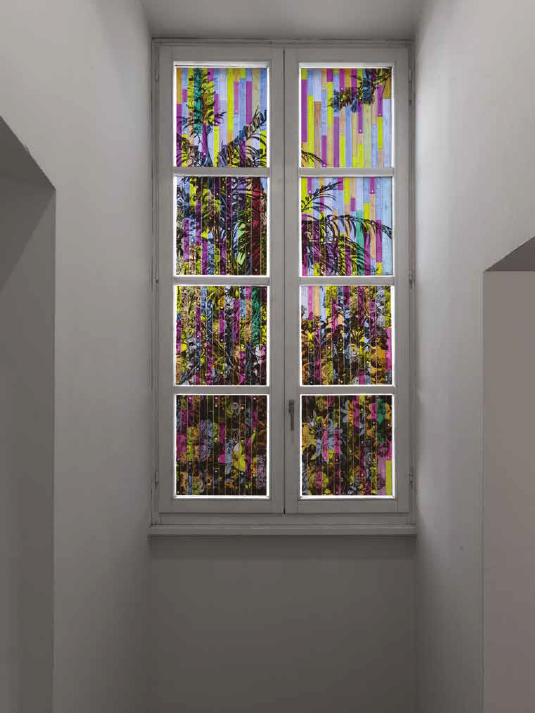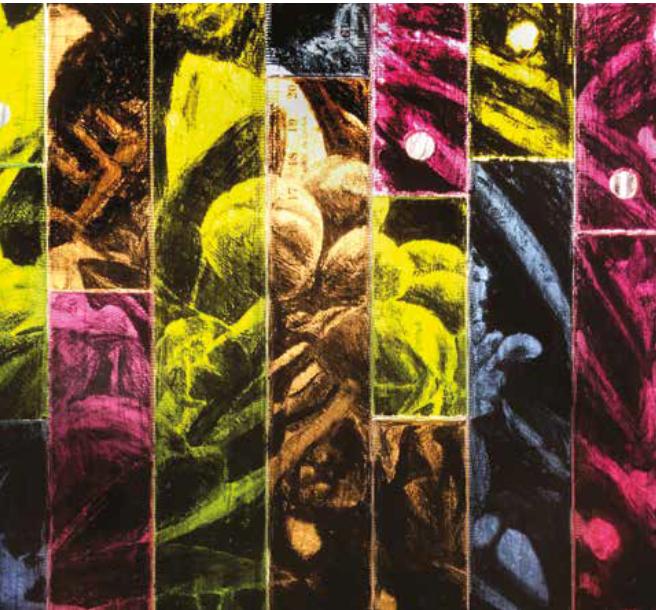[English text below]
Come accade spesso nei vecchi palazzi, un piccolo passaggio può aprirsi su visioni sorprendenti. È il caso della seconda stanza, dominata da una grande finestra aperta sulla facciata bicroma della pieve di Sant’Andrea, su cui poggia la seconda opera in mostra. È una vetrata colorata appositamente disegnata con la matita litografica su uno strato di righelli colorati, usati a scuola dai bambini. La tecnica ideata da Andrea è stata messa alla prova in questi anni su superfici enormi, in un inseguimento della tradizione delle vetrate istoriate che ha qualcosa di erculeo e femmineo insieme. Uno degli ultimi episodi è stato il grande intervento sulle finestre della Galleria Nazionale d’Arte Moderna e Contemporanea di Roma (2019), che ha trasformato la luce della cosiddetta Connection Gallery del museo con un’invasione cromatica, tra lussuria e tradizione. A Pistoia l’intervento cambia scala, tema e temperatura emotiva: san Giorgio è sempre la realtà da inglobare e il drago lascia il posto alla principessa: alla lussuria romana si sostituisce la santità del sacrificio. Su un supporto che ricorda la gioia come i righelli fluorescenti, si stende ora l’immagine di una cascata di fiori: multiformi, multispecie e multicolore. Il tormento, come nell’aiuola di libri, anche in questo caso è sottopelle ma ineludibile. I fiori sono solo i più delicati, tra gli attributi dei martiri, segno di violenza subita e purezza vissuta. Qui si affastellano uno sull’altro, sotto una palma, il simbolo universale del martirio. Si tratta di un omaggio a un altro eccidio poco lontano, anch’esso nascosto da una facciata splendida: la Strage degli Innocenti del pulpito di Giovanni Pisano, conservato a pochi metri, in Sant’Andrea. L’opera ha preso il suo titolo in un battito di pensiero: Andrea si è perso è un omaggio alla canzone di Fabrizio De André che, come la chiesa, porta il nome dell’artista. Siamo nel pieno dello struggimento della fine, al centro del cortocircuito di amori umani e divini di questo prezioso crocevia.
ANDREA GOT LOST
As often happens in old palazzos, a little passageway may open up to surprising vistas. This is the case of the second room, dominated by a large window opening onto the two-tone façade of the church of St Andrew, where the second work on show is positioned. It’s a piece of colored glass, decorated especially with a lithographic pencil onto a layer of colored lines, like those used by children at school. Andrea’s technique has been put to the test over recent years on huge surfaces, following in the tradition of stained-glass windows, which has something both Herculean and feminine at the same time. One of the most recent episodes was his major intervention on the windows of the Galleria Nazionale d’Arte Moderna e Contemporanea in Rome (2019), transforming the light of the so-called Connection Gallery of the museum with a chromatic invasion, between excess and tradition. In Pistoia, the intervention changes scale, theme, and emotional warmth: St George is once more the reality to be englobed and the dragon gives way to the princess: the Roman sense of lustfulness is replaced by the sanctity of sacrifice.
Through a medium reminiscent of joy like fluorescent lines, the image now spreads out of a cascade of flowers: multiform, multispecies, and multicolor. Like in the field of books, also in this case the sense of torment inevitably gets under our skin. Among the attributes of the martyrs, the flowers are just the most delicate sign of violence su#ered and purity experienced. Here they are piled one on top of the other, beneath a palm, the universal symbol of martyrdom. It is in fact a homage to another massacre that took place not so far away, also hidden by a splendid façade: the Strage degli Innocenti in the pulpit of Giovanni Pisano, housed only a few meters away, there in the church of St Andrew. The work is immediately given a title: Andrea si è perso is a homage to the song by Fabrizio De André which, just like the church, bears the name of the artist himself.
We are caught up in the final yearning, at the heart of the short circuit of human and divine love of this precious intersection.

